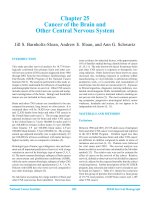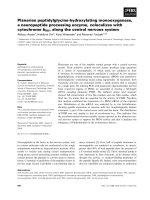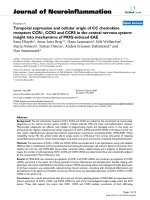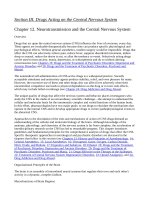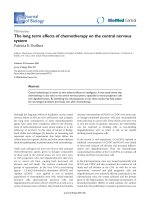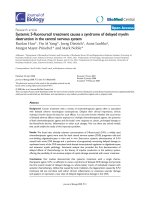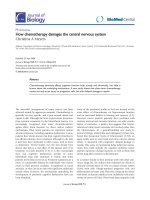The role of hydrogen sulfide in the central nervous system implications in the treatment of alzheimers disease
Bạn đang xem bản rút gọn của tài liệu. Xem và tải ngay bản đầy đủ của tài liệu tại đây (5.69 MB, 155 trang )
THE ROLE OF HYDROGEN SULFIDE IN THE CENTRAL NERVOUS
SYSTEM: IMPLICATIONS IN TREATMENT OF ALZHEIMER’S
DISEASE
BHUSHAN VIJAY NAGPURE
NATIONAL UNIVERSITY OF SINGAPORE
2014
THE ROLE OF HYDROGEN SULFIDE IN THE CENTRAL NERVOUS
SYSTEM: IMPLICATIONS IN TREATMENT OF ALZHEIMER’S
DISEASE
BHUSHAN VIJAY NAGPURE
(M.B.B.S., Maharashtra University of Health Sciences, India)
A THESIS SUBMITTED
FOR THE DEGREE OF DOCTOR OF PHILOSOPHY
DEPARTMENT OF PHARMACOLOGY
NATIONAL UNIVERSITY OF SINGAPORE
2014
DECLARATION
I hereby declare that this thesis is my original work and it has been written by
me in its entirety. I have duly acknowledged all the sources of information that
have been used in the thesis.
This thesis has also not been submitted for any degree in any university
previously.
Bhushan Vijay Nagpure
21st July 2014
I
ACKNOWEDGEMENTS
First of all, I would like to express my deepest gratitude to my
supervisor, A/P Bian Jinsong, for providing me the opportunity to continue
with my graduate studies. I appreciate his scientific advices during the course
of study. I also want to thank him for his support and encouragement
throughout my journey of PhD.
Sincere appreciation to the lab technologist, Ms. Shoon Mei Leng, for
assisting with laboratory matters. Many thanks to my fellow past and present
colleagues at A/P Bian Jinsong’s laboratory, Wu Zhiyuan, Hua Fei, Cao Xu,
Xie Li, Tiong Chi Xin, Li Guang, Liu Yanying, Liu Yitong, Lu Ming and Hu
Lifang for their insightful discussion, technical advice and help in one way or
another.
I would also extend my gratitude to Yong Loo Lin School of Medicine,
National University of Singapore for offering me scholarship and providing
me the opportunity to pursue higher studies in Singapore.
Finally, I would also like to convey my greatest gratitude to my
parents, my brother and my wife for their continuous love, encouragement and
support in past few years.
II
TABLE OF CONTENTS
ACKNOWEDGEMENTS ............................................................................. II
TABLE OF CONTENTS .............................................................................. III
SUMMARY.................................................................................................. VII
LIST OF TABLES ..........................................................................................X
LIST OF FIGURES ...................................................................................... XI
LIST OF ABBREVEATIONS.................................................................... XII
LIST OF PUBLICATIONS ....................................................................... XIV
1
Introduction and Literature Review ....................................................... 1
1.1 The trio of gasotransmitters ................................................................. 2
1.1.1 H2S- The ‘third’ gasotransmitter ....................................................... 2
1.1.1.1 Physical and chemical properties of H2S..................................... 3
1.1.1.2 Toxicity of H2S ............................................................................ 4
1.1.1.3 Biosynthesis of H2S ..................................................................... 6
1.1.1.4 Storage and metabolism of H2S ................................................... 8
1.1.1.5 Biological role of H2S in CNS..................................................... 9
1.2 Alzheimer’s disease.............................................................................. 16
1.2.1 History ............................................................................................. 16
1.2.2 Epidemiology .................................................................................. 17
1.2.3 Risk factors ...................................................................................... 19
1.2.4 Pathology ......................................................................................... 20
1.2.4.1 Amyloid β .................................................................................. 20
1.2.4.2 Tau ............................................................................................. 21
1.2.4.3 Studies done on animal models and AD patients ...................... 22
1.2.4.4 Other etiopathological hypotheses ............................................ 23
1.2.5 ATP and its metabolites in AD........................................................ 26
1.2.6 Diagnosis and clinical symptoms of AD ......................................... 28
1.2.6.1 Classification and Diagnostic criteria ........................................ 28
1.2.6.2 Clinical symptoms and the course of the illness ....................... 29
1.2.7 Pharmacotherapy ............................................................................. 31
1.3
2
Objectives ............................................................................................. 34
Materials and methods ........................................................................... 36
2.1
Chemicals .............................................................................................. 37
2.2
Cell Culture and Treatments .................................................................. 37
2.3
Constructs and Mutagenesis .................................................................. 39
III
2.4
Preparation of Primary Astrocyte Culture ............................................. 40
2.5
Cell Viability Assay............................................................................... 40
2.6
Intracellular cAMP Assay ..................................................................... 41
2.7
Cell Fractionation and Adenylyl Cyclase (AC) Activity Assay ............ 41
2.8
γ-secretase (Fluorogenic Substrate) Assay ............................................ 42
2.9
ELISA for Aβ42 .................................................................................... 42
2.10
Reactive Oxygen Species (ROS) Measurement .................................. 43
2.11
Measurement of Nitric Oxide.............................................................. 43
2.12
ELISA for TNF-α and IL-Iβ................................................................ 43
2.13
DNA binding activity assay ................................................................ 43
2.14
Cathepsin S activity assay ................................................................... 44
2.15
S-sulfhydration assay (modified biotin switch) .................................. 44
2.16
Glutamate uptake assay ....................................................................... 45
2.17
Reverse Transcription-PCR................................................................. 45
2.18
Western Blot Assay ............................................................................. 47
2.19
Statistical Analysis .............................................................................. 47
3 Hydrogen sulfide inhibits A2A adenosine receptor agonist induced βamyloid production in SH-SY5Y neuroblastoma cells via a cAMP
dependent pathway ....................................................................................... 49
3.1
Introduction ......................................................................................... 50
3.2 Materials and Methods ....................................................................... 52
3.2.1 Chemicals ........................................................................................ 52
3.2.2 Cell Culture and Treatments............................................................ 52
3.2.3 Cell Viability Assay ........................................................................ 52
3.2.4 Intracellular cAMP Assay ............................................................... 52
3.2.5 Cell Fractionation and Adenylyl Cyclase (AC) Activity Assay...... 52
3.2.6 γ-secretase (Fluorogenic Substrate) Assay ...................................... 52
3.2.7 ELISA for Aβ42 .............................................................................. 52
3.2.8 Reverse Transcription-PCR ............................................................. 52
3.2.9 Western Blot Assay ......................................................................... 52
3.2.10 Statistical Analysis ........................................................................ 53
3.3 Results ................................................................................................... 53
3.3.1 NaHS attenuates adenosine A2A receptor agonist stimulated Aβ42
production .................................................................................................... 53
3.3.2 The involvement of cAMP/PKA/CREB pathway in the inhibitory
effect of NaHS on HENECA-stimulated Aβ42 production......................... 56
IV
3.3.3
3.3.4
3.3.5
3.3.6
3.4
NaHS targets activated AC, not A2A receptors .............................. 59
NaHS inhibits APP production and maturation .............................. 62
NaHS attenuates γ–secretase activity, not of β–secretase ............... 64
Effect of NaHS on expression of presenilins .................................. 67
Discussion ............................................................................................. 68
4 Hydrogen sulfide repairs impaired glutamate uptake in A2A
adenosine receptor agonist-stimulated primary astrocytes ....................... 77
4.1
Introduction ......................................................................................... 78
4.2 Material and Methods ......................................................................... 79
4.2.1 Chemicals ........................................................................................ 79
4.2.2 Primary astrocyte culture................................................................. 80
4.2.3 Intracellular cAMP Assay ............................................................... 80
4.2.4 Glutamate uptake assay ................................................................... 80
4.2.5 Statistical analysis ........................................................................... 80
4.3 Results ................................................................................................... 80
4.3.1 The effect of NaHS on glutamate uptake in A2A adenosine receptor
agonist stimulated astrocytes ....................................................................... 81
4.3.2 The involvement of cAMP signaling pathway in the protective effect
of NaHS on HENECA-stimulated astrocytes .............................................. 82
4.4
Discussion ............................................................................................. 83
5 Hydrogen sulfide inhibits the Aβ synthesis and neuroinflammation in
extracellular ATP-stimulated BV-2 microglia cells via inhibition of NF-κB
, STAT3 and cathepsin S activation ............................................................. 86
5.1
Introduction ......................................................................................... 87
5.2 Materials and Methods ....................................................................... 90
5.2.1 Chemicals ........................................................................................ 90
5.2.2 Cell Culture and Treatments............................................................ 90
5.2.3 Constructs and mutagenesis ............................................................ 90
5.2.4 Cell Viability Assay ........................................................................ 90
5.2.5 Intracellular cAMP Assay ............................................................... 90
5.2.6 γ-secretase (Fluorogenic Substrate) Assay ...................................... 90
5.2.7 ELISA for Aβ42 .............................................................................. 90
5.2.8 Reactive Oxygen Species (ROS) Measurement .............................. 90
5.2.9 Nitric oxide (NO) Measurement...................................................... 90
5.2.10 DNA binding activity assay .......................................................... 91
5.2.11 Cathepsin S activity assay ............................................................. 91
5.2.12 S-sulfhydration assay .................................................................... 91
5.2.13 Western Blot Assay ....................................................................... 91
5.2.14 Statistical Analysis ........................................................................ 91
5.3
Results ................................................................................................... 91
V
5.3.1 Effect of NaHS on ATP-induced oxidative stress and inflammation
in BV-2 microglial cells .............................................................................. 91
5.3.2 Effect of NaHS on ATP-induced iNOS and COX-2 expression in
microglial cells ............................................................................................ 94
5.3.3 Effect of NaHS on DNA binding and transcriptional activities of
NF-κB in ATP-stimulated microglial cells .................................................. 96
5.3.4 Effect of NaHS on ATP-induced Aβ42 production in microglial cells
98
5.3.5 Effect of NaHS on STAT3 activity in microglial cells ................. 101
5.3.6 Involvement of cathepsin S in the observed effects of NaHS on
ATP-induced neuroinflammation and Aβ production ............................... 103
5.4
Discussion ........................................................................................... 107
6 General Discussion, Limitations of study, Future directions and
Conclusion .................................................................................................... 113
Bibliography ................................................................................................ 120
VI
SUMMARY
In today’s world, Alzheimer’s disease (AD) is the leading cause of
dementia in elderly population across the world. It is also the most common
neurodegenerative disease. With high prevalence and ever growing incidence
rate, AD is set to become one of the most crippling diseases in developed and
developing countries. Currently, only few approved drugs are available for the
treatment of AD. Majority of them are prescribed to alleviate neuropsychiatric
symptoms without targeting underlying pathological mechanism. Hence, a lot
of efforts have been put into the development of disease-modifying drug
therapy.
Amyloidogenesis is one of the main culprits of AD pathology. The
effect of NaHS, a rapid exogenous hydrogen sulfide (H2S) donor, was first
examined in SH-SY5Y cells transfected with amyloid precursor protein (APP)
Swedish mutation. H2S pretreatment was found to exert an inhibitory effect on
Aβ42 synthesis by HENECA (a selective A2A receptor agonist)-stimulated
SH-SY5Y cells. NaHS also interfered with the maturation process of APP by
inhibiting its generation and post-translational modification. A further study of
the rate limiting steps of Aβ synthesis i.e. β- and γ-secretase activities yielded
interesting results. H2S did not affect the β-secretase activity. However, γsecretase activity measurement and gene expression study of presenilins
revealed that H2S directly inhibited γ-secretase. Curiously, H2S also abrogated
intracellular cAMP levels and phosphorylation of downstream CREB. H2S had
similar suppressive effects on cAMP and Aβ42 generation caused by specific
AC stimulation. A further study showed that HENECA-stimulated AC activity
VII
and gene expression of AC isoforms were preferentially blocked by H2S while
exerting its inhibitory action on Aβ synthesis.
A2A adenosine receptors are known to modulate glutamate uptake in
astroglial cells. When incubated with HENECA, protein expression of GLAST
glutamate transporter and glutamate uptake were significantly inhibited in
astrocytes. The pretreatment with NaHS significantly improved the impaired
glutamate uptake and expression of GLAST glutamate transporter. Being
positively linked to AC, stimulation of A2A receptors by HENECA resulted
into the increase in intracellular cAMP levels. Similar to the first part of the
studies, NaHS inhibited the cAMP production in astrocytes. These data
suggest that H2S -inhibited cAMP production was probably responsible for its
regenerative effect on glutamate uptake and restoration of GLAST.
Several line of evidences show that severe neuroinflammation leads to
amyloidogenesis in the CNS. By the detailed analysis of generation of many
inflammatory parameters, it was found that H2S pretreatment suppressed
extracellular ATP-induced severe neuroinflammation in immortalized BV-2
cells. While exerting its anti-inflammatory effect, H2S also imparted the
inhibitory effect on Aβ synthesis in microglia. NF-κB and STAT3 are
responsible for transcription of many inflammatory genes. The activation of
both the transcription factors was blocked by H2S. Cathepsin S, which was
found to be situated downstream to STAT3 in the current study, was involved
in β-secretase cleavage of APP and NF-κB activation. We found that H2S ssulfhydrated Cathepsin S and inhibited its expression and activity in ATPstimulated BV-2 cells.
VIII
In conclusion, the present study demonstrated that H2S is a potent
neuroprotective agent against AD pathology. H2S therapy has a potential to be
an effective and promising therapeutic strategy against AD as it acts on the
multiple targets in the pathological process of the disease.
IX
LIST OF TABLES
Table 1 Health effects of H2S at various approximate exposure levels......................... 6
Table 2 Prevalence and incidence of dementia in developed and developing regions 19
Table 3 Evaluation of dementia ................................................................................... 31
X
LIST OF FIGURES
Figure 3.1 Effects of NaHS on Aβ42 synthesis and cell viability in APPswe
transfected SH-SY5Y cells. ..................................................................... 55
Figure 3.2 The involvement of cAMP signaling pathway in the observed
effects of NaHS on Aβ42 production. ..................................................... 59
Figure 3.3 Effect of NaHS on genes expression of neuron-specific AC
isoforms and AC activity ......................................................................... 62
Figure 3.4 Inhibitory effects of NaHS on APP production and maturation. ... 64
Figure 3.5 Different effect of NaHS on activities of β- and γ-secretases........ 66
Figure 3.6 NaHS inhibits mRNA expressions of presenilins 1 and 2 ............. 68
Figure 3.7 Schematic diagram depicting the inhibitory effect of H2S on
HENECA induced Aβ production in APPswe transfected SH-SY5Y cells
.................................................................................................................. 76
Figure 4.1 Effect of NaHS on GLAST protein expression..…………...…….81
Figure 4.2 Effect of NaHS on glutamate uptake………..……………………82
Figure 4.3 Effect of NaHS on glutamate uptake in HENECA-stimulated
astrocytes involves cAMP signaling pathway………………………………..83
Figure 5.1: Effect of NaHS on ATP-induced oxidative stress and inflammation
in BV-2 microglial cells……………………………………………………...94
Figure 5.2: Effect of NaHS on protein expression of iNOS and COX-2…….96
Figure 5.3: Effect of NaHS on DNA binding and transcriptional activities of
NF-κB………………………………………………………………………..98
Figure 5.4: Effect of NaHS on ATP-induced Aβ42 production……………100
Figure 5.5: Effect of NaHS on STAT3 activity…………………………….102
Figure 5.6: Involvement of cathepsin S…………………………………….106
XI
LIST OF ABBREVEATIONS
Aβ42
β-Amyloid 1-42
AC
Adenylyl cyclase
AD
Alzheimer‘s disease
APP
Amyloid precursor protein
ATP
Adenosine triphosphate
BACE1
β-site amyloid precursor protein cleaving enzyme 1
cAMP
3'-5'-Cyclic adenosine monophosphate;
CAT
Cysteine aminotransferase
CBS
Cystathionine-β-synthase
CNS
Central nervous system
CO
Carbon monoxide
COX-2
Cyclooxygenase-2
CREB,
cAMP responsive element binding protein;
CSE
Cystathionine-γ-lyase
ELISA
Enzyme linked immunosorbent assay
GABA
γ-aminobutyric acid
H2 S
Hydrogen sulfide
HD
Huntington‘s disease
HENECA,
2-Hexynyladenosine-5'-N-ethylcarboxamide
IBMX,
3-Isobutyl-1-methylxanthine
IL-1β
Interleukin 1β
iNOS
Inducible nitric oxide synthase
KATP
ATP-sensitive potassium channel
LPS
Lipopolysaccharide
LTP
Long-term potentiation
MAO
Monoamine oxidase
XII
3-MST
3-mercaptopyruvate sulfurtransferase
mitoKATP
Mitochondrial KATP channel
NaHS
Sodium hydrogen sulfide
NF-κB
Nuclear factor kappa-light-chain-enhancer of activated B cells
NMDA
N-methyl-D-aspartic acid
NO
Nitric oxide
NSAIDs
Non-steroidal anti-inflammatory drugs
PCR
Polymerase chain reaction
PD
Parkinson‘s disease
PKA
Protein kinase A
ROS
Reactive oxygen species
STAT3
Signal transducers and activators of transcription 3
TNF-α
Tumor necrosis factor-α
XIII
LIST OF PUBLICATIONS
Original Research PapersÔ Nagpure BV, Bian JS. H2S inhibits A2A adenosine receptor agonist
induced β-amyloid production in SH-SY5Y neuroblastoma cells via a
cAMP dependent pathway. PLOS One. 2014 Feb 11;9(2):e88508. doi:
10.1371/journal.pone.0088508. eCollection 2014
Ô Liu YY, Nagpure BV, Bian JS. H2S protects SH-SY5Y neuronal cells
against d-galactose induced cell injury by suppression of advanced
glycation end products formation and oxidative stress. Neurochem Int.
2013 Apr;62(5):603-9. doi:10.1016/j.neuint.2012.12.010. Epub 2012
Dec 26.
Ô Nagpure BV, Wu Zhiyuan, Bian JS. H2S inhibits neuroinflammation
and the production of β-amyloid in BV-2 microglia cells by inhibiting
STAT3 and Cathepsin S (Ready for submission to Antioxidants &
Redox Signaling).
Invited Review PaperÔ Nagpure BV, Bian JS. Interaction of hydrogen sulfide with nitric
oxide in the cardiovascular system. (Accepted in Oxidative Medicine
and Cellular Longevity).
Invited Book ChaptersÔ Nagpure BV, Bian JS. Brain, learning and memory: Role of H2S in
neurodegenerative
diseases.
Chemistry,
Biochemistry
and
Pharmacology of H2S (Submitted and in communication with the
editors)
Ô Yang HY, Nagpure BV, Bian JS. Opioid dependence and the
adenylyl cyclase/cAMP signaling. The Neuropathology Of Drug
Addictions And Substance Misuse (Submitted and in communication
with the editors)
International/ Local Conferences presentations
Ô Nagpure BV, Bian JS. Hydrogen Sulfide: A novel agent to protect
kidney against hypertensive renal injury. Oral Presentation at Second
XIV
Scientific meeting, National Kidney Foundation, Singapore (March
2014)
Ô Nagpure BV, Bian JS. Hydrogen sulfide attenuates Beta-Amyloid
production in a cell model of Alzheimer's disease. Poster Presentation
at International Conference of Pharmacology and Drug Development,
Singapore (December 2013)
Ô Nagpure BV, Bian JS. Neuroprotective effect of hydrogen sulfide:
regulation of amyloidosis and inflammation in SH-SY5Y
neuroblastoma and BV-2 microglia cells. Oral Presentation at Second
European Conference on the Biology of Hydrogen Sulfide, Exeter, UK
(Sept 2013)
XV
1
Introduction and Literature Review
1
1.1 The trio of gasotransmitters
In recent few decades, the scientific community has witnessed the rise of a
whole new class of gaseous biological mediators in mammalian cells. The size
of this family is growing continually over the years since the seminal
discovery of physiological effects of nitric oxide (NO) on blood vessels
(Ignarro et al., 1987). With relatively recent recognition of carbon monoxide
(CO) and hydrogen sulfide (H2S) as two more gaseous signaling molecules,
the term ‘gasotransmitter’ was coined. As the name suggests, they are simple
gas molecules, which are lipid soluble and hence freely membrane permeable
reaching intracellular organelle. In contrast to the conventional idea of typical
signaling molecules, these gasotransmitters are synthesized endogenously on
‘as and when required’ basis from specific enzymes in highly regulated
manner. Many studies over decades studies have revealed that these
gasotransmitters have specific molecular targets and well defined biological
functions at physiological concentrations (Wang, 2002b).
1.1.1
H2S- The ‘third’ gasotransmitter
The physiological role of H2S was discovered by a Japanese group of
scientists led by Abe and Kimura in 1996. In their pioneering study, the novel
neuromodulator role of H2S was transpired (Abe and Kimura, 1996). Since
then its possible roles in all body systems were and are being investigated
worldwide. In mammalian central nervous system (CNS), its prominent effects
include modulation of neurotransmission and long-term potentiation (Abe and
Kimura, 1996) and induction of neuroprotection (Hu et al., 2011) from myriad
2
of pathogenic agents. In mammalian cardiovascular system (CVS), its
protective effects are deeply studied (Polhemus et al., 2014, Liu et al., 2012).
The induction of relaxation (Yang et al., 2008) and constriction (Kohn et al.,
2012) in various types of blood vessels is also documented (d'Emmanuele di
Villa Bianca et al., 2011). The opposite effects of H2S on systemic and
localized inflammation have been observed in various mammalian tissues
(Whiteman and Winyard, 2011, Hegde and Bhatia, 2011). As more and more
physiological and pharmacological implications of H2S are explored, we can
say that its whiff has blossomed (Wang, 2012).
1.1.1.1 Physical and chemical properties of H2S
At room temperature and ambient pressure, H2S exists in a colorless
gaseous form. The smell is very pungent with distinctive rotten-egg odour. It
is readily water soluble due to its weak acidic nature. Its solubility was
measured to be 80 mM at 37 °C as equilibrium between H2S, HS- and S2-. The
acid dissociation constant (pKa) values of the first and second dissociation
steps are recorded as 7.0 and >12.0, respectively (Vorobets et al., 2002, Kabil
and Banerjee, 2010, Mark et al., 2011). Thus, at physiological pH of 7.4, H2S
exists majorly as HS- moiety along with minor presence of free H2S in its
dissociated form. The minute amounts of sulfide anions (S2-) can also be
detected. Even with the advent of various methods of H2S measurement, it’s
almost impossible to determine the active form of H2S (H2S, HS- or S2-)
present in the biological system. Hence the all-encompassing term of H2S is
now used to refer the total sulfide content present in the solution (i.e. H2S +
HS-+ S2-) (Zhao et al., 2014b).
3
1.1.1.2 Toxicity of H2S
H2S is often a lethal environmental and occupational hazard that has a
unique pattern of toxicity. It is the second most common cause (at 7.7%, after
carbon monoxide at 36%) of fatal gas inhalation exposure at the workplaces
like oil rigs and urban sewers (Guidotti, 2010). Its exposure-response curve for
lethality is steep, thus concentration of inhaled gas is more important
compared to the duration of exposure (Prior et al., 1988, Guidotti, 1996). The
approximate concentrations (exposure levels) of inhaled H2S for the major
toxicological effects are given in table 1. The toxidrome (i.e. a set of
symptoms and signs associated with a particular poison) of H2S is often
considered as one of the most unusual and reliable toxidromes (Milby and
Baselt, 1999, Wang, 1989). It is characterized by the ‘knockdown’ (acute
central neurotoxicity), pulmonary edema, conjunctivitis and odor perception
followed by respiratory paralysis (Guidotti, 2010). Acute toxicity leading to
reversible unconsciousness caused by H2S inhalation are called as
‘knockdowns’ (Guidotti, 1996). Although knockdowns can be fatal in the
cases of prolonged high-concentration exposure of about 500-1000 ppm
(about 15-30 mM), the transient exposure is often reversible and apparently
complete functionally (Burnett et al., 1977). Pulmonary edema is a wellrecognized effect of acute H2S toxicity. As H2S has relatively high solubility,
it penetrates deeply into respiratory track, causing alveolar injury culminating
in acute pulmonary edema (Guidotti, 2010). The conjunctivitis, caused by
prolonged low-concentration exposure of about 20 ppm (about 500 uM)
(Lambert et al., 2006) is peculiarly associated with reversible chromatic
distortion and visual changes. These symptoms are sometimes accompanied
4
by blepherospasm and photophobia (Tansy et al., 1981, Milby and Baselt,
1999). H2S is an odorous gas at low concentration of 0.01-0.3 ppm (about 0.09
mM). As the concentration increases, however, the victims start to experience
olfactory fatigue. It is a sensory adaptation where the victims get accustomed
to strong odor. At around 100 ppm (about 3 mM) concentration, H2S paralyses
the olfactory mechanism, preventing perception of any smell. This
phenomenon removes the primary warning sign of H2S exposure (Ronk and
White, 1985, Turner et al., 1990).
Concentration
Effects
(ppm)
Minimum concentration detected by human nose (may
0.01-0.3
differ from person to person)
Generally tolerated pungent smell, although some
1-5
people can shows symptoms like nausea, mild
lacrimation and possible heavy-headedness
Threshold for anaerobic metabolism in normal person
10
during exercise
Strong characteristic odor, probable eye irritation or
20
conjunctivitis
Eye and lung irritation, delayed eye damage in few
20-50
victims, appearance of symptoms of gastric
disturbances
Eye and lung irritation; olfactory paralysis,
100
disappearance of character pungent odor
5
150-200
Severe eye and lung irritation, sense of smell paralyzed
250-500
Long term exposure might lead to pulmonary edema
Serious damage to eyes, severe lung irritation,
500
knockdown and death within 4-8 hours, amnesia for
period of exposure
1000
Immediate cessation of breathing; instant collapse
Table 1 Health effects of H2S at various approximate exposure levels. Data is reproduced
from (Guidotti, 1996, Guidotti, 2010) with some modifications.
1.1.1.3 Biosynthesis of H2S
In mammalian tissues, H2S is biosynthesized from amino acid cysteine
(Cys) and homocysteine (Hcy), which are recognized as the principle
substrates for its endogenous production.
They are acted upon by three
different enzymes, namely cystathionine β-synthase (CBS), cystathionine γlyase (CSE) and 3-mercaptopyruvate sulfur transferase (3-MST) (Hu et al.,
2011). Expressions of these enzymes are variable in different tissues. The
study of this variation is important as the modulation of endogenous
production of H2S can be achieved by targeting each enzyme separately or
concurrently.
A pyridoxal-5’-phosphate (PLP)-dependent enzyme, CBS, initiates the
trans-sulfuration pathway by catalyzing β-replacement of serine by Hcy to
generate cystathionine and water. Furthermore, serine replacement by cysteine
as a substrate results into production of cystathionine and H2S. Besides above
mentioned trans-sulfuration pathway, CBS also catalyzes condensation
6
reactions between two molecules of Cys and β-replacement of Cys by water to
produces H2S (Kabil and Banerjee, 2014). The reaction replacing Hcy by Cys
yields maximum generation of H2S in vitro (Singh et al., 2009). CBS is found
to be primarily expressed in various regions of the human brain (Abe and
Kimura, 1996).
CSE is yet another PLP-dependent enzyme, which mediates a reaction
between thiocysteine and a thiol compound R-SH to generate H2S (Kimura,
2011). The substrate thiocysteine is generated from L-cystine which in turn is
produced by two L-cysteine molecules (Yamanishi and Tuboi, 1981).
Expression of CSE is rather widely distributed among peripheral tissues
including liver, pancreas, uterus and intestine (Kimura, 2011). It is the main
H2S-generating enzyme in the cardiovascular system (Zhao et al., 2001, Bian
et al., 2006). CSE was detected in relatively large amounts in the myocardium
(Geng et al., 2004), endothelial cells (ECs) (Yang et al., 2008), and smooth
muscle cells (Zhao et al., 2001).
The third enzyme, 3-mercaptopyruvate sulfotransferase (3-MST), was
identified in the neurons. The research group detected the significant presence
of H2S in the brain homogenate preparation of CBS-/- mice (Shibuya et al.,
2009). Kimura further observed that 3-MST acts together with cysteine
aminotransferase (CAT) to generate H2S from Cys in the presence of αketoglutarate (Kimura et al., 2010). However, it is suggested that 3-MST is
unable to produce H2S in normal physiological conditions as they exert their
activities at higher alkaline pH level. Furthermore, it requires endogenous
reducing substances such as thioredoxin and dihydrolipoic acid (DHLA) for
the production of H2S (Kimura, 2014). Aspartate can also act as a substrate for
7
CAT, competitively binding to it and attenuating H2S synthesis (Guo et al.,
2012).
Recently, Shibuya et al discovered the additional pathway for H2S
biosynthesis in mammalian cells. 3-MST along with D-Amino acid oxidase
(DAO) produces H2S from D-Cysteine by the interaction of mitochondria and
peroxisomes. It was evident that this D-Cysteine dependent pathway operates
predominantly in the cerebellum and the kidney. The protective effects of DCysteine were observed against oxidative stress in cerebellar neurons and
against ischaemia-reperfusion injury in the kidney (Shibuya and Kimura,
2013).
1.1.1.4 Storage and metabolism of H2S
Although endogenous H2S can be synthesized and released
immediately, the storage forms of H2S are also known. Acid-labile sulfur is
primarily contained in iron-sulfur center of mitochondrial enzymes and can
release H2S only in acidic pH of 5.4. Due to higher instability of iron-sulfur
complexes, the release of H2S is readily achieved. Bound sulfane sulfur, which
is localized in cytoplasm, consists of divalent sulfur bond (e.g. persulfide
form). It releases H2S under reducing conditions of pH 8.4 (Ishigami et al.,
2009). It is possible that H2S produced by 3-MST/CAT enzymatic pathway is
stored in the bound sulfane sulfur form. The decreased amount of bound
sulfane sulfur has been detected in cells without 3-MST/CAT compared to the
cells with it (Shibuya et al., 2009).
H2S is catabolized in mammalian cells though various pathways. The
major mechanism is through its mitochondrial oxidation in different tissues
8
